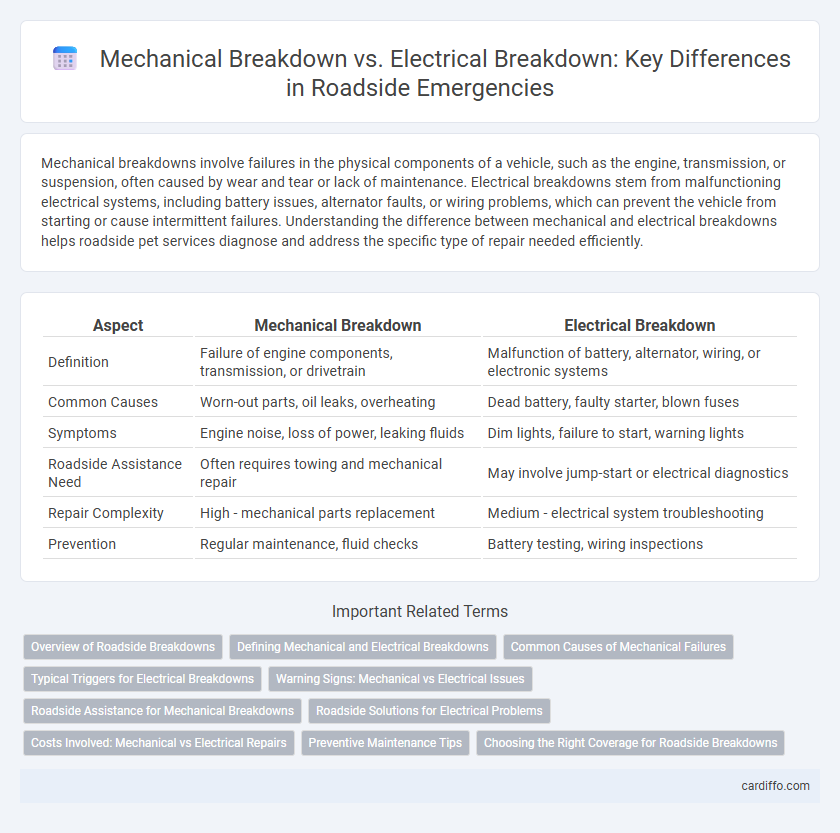Mechanical breakdowns involve failures in the physical components of a vehicle, such as the engine, transmission, or suspension, often caused by wear and tear or lack of maintenance. Electrical breakdowns stem from malfunctioning electrical systems, including battery issues, alternator faults, or wiring problems, which can prevent the vehicle from starting or cause intermittent failures. Understanding the difference between mechanical and electrical breakdowns helps roadside pet services diagnose and address the specific type of repair needed efficiently.
Table of Comparison
| Aspect | Mechanical Breakdown | Electrical Breakdown |
|---|---|---|
| Definition | Failure of engine components, transmission, or drivetrain | Malfunction of battery, alternator, wiring, or electronic systems |
| Common Causes | Worn-out parts, oil leaks, overheating | Dead battery, faulty starter, blown fuses |
| Symptoms | Engine noise, loss of power, leaking fluids | Dim lights, failure to start, warning lights |
| Roadside Assistance Need | Often requires towing and mechanical repair | May involve jump-start or electrical diagnostics |
| Repair Complexity | High - mechanical parts replacement | Medium - electrical system troubleshooting |
| Prevention | Regular maintenance, fluid checks | Battery testing, wiring inspections |
Overview of Roadside Breakdowns
Roadside breakdowns commonly result from mechanical failures such as engine overheating, transmission issues, or brake malfunctions, which affect a vehicle's core operational systems. Electrical breakdowns involve problems with the battery, alternator, or wiring, disrupting essential functions like ignition, lighting, and electronic controls. Understanding the distinct causes helps prioritize timely repairs and roadside assistance interventions.
Defining Mechanical and Electrical Breakdowns
Mechanical breakdowns involve failures in physical components like the engine, transmission, or suspension that impair vehicle operation. Electrical breakdowns pertain to malfunctions in the vehicle's electrical systems, including the battery, alternator, wiring, or sensors. Understanding the distinction helps in diagnosing issues and determining appropriate roadside assistance or repairs.
Common Causes of Mechanical Failures
Mechanical breakdowns often result from worn-out components such as gears, belts, and bearings, which degrade over time due to friction and lack of lubrication. Common causes include overheating engines, broken timing chains, and fluid leaks that impair hydraulic or transmission systems. Regular maintenance, including timely oil changes and inspections, helps prevent these mechanical failures on the roadside.
Typical Triggers for Electrical Breakdowns
Electrical breakdowns during roadside incidents often stem from common triggers such as battery failure, alternator issues, and faulty wiring or blown fuses. Corrosion on battery terminals and loose electrical connections can disrupt power flow, leading to sudden loss of vehicle functionality. Complex electronic control modules and sensors also contribute to electrical faults, especially in modern vehicles with advanced electrical systems.
Warning Signs: Mechanical vs Electrical Issues
Mechanical breakdowns often exhibit warning signs such as unusual engine noises, overheating, and fluid leaks, indicating issues with components like the engine, transmission, or brakes. Electrical breakdowns typically present symptoms including dimming headlights, dashboard warning lights, and failure of electronic systems, signaling problems with the battery, alternator, or wiring. Recognizing these distinct warning signs enables timely roadside diagnostics and prevents further vehicle damage.
Roadside Assistance for Mechanical Breakdowns
Roadside assistance for mechanical breakdowns primarily addresses issues such as engine failure, transmission problems, and brake malfunctions that prevent a vehicle from operating safely. Unlike electrical breakdowns, which often involve battery, starter motor, or alternator failures, mechanical breakdowns require specialized tools and expertise to diagnose and repair on-site or arrange for towing to a service center. Timely roadside support for mechanical failures reduces vehicle downtime and enhances driver safety during emergencies.
Roadside Solutions for Electrical Problems
Roadside solutions for electrical breakdowns focus on diagnosing and repairing issues such as dead batteries, faulty alternators, and wiring faults to restore vehicle functionality quickly. Mobile technicians use specialized diagnostic tools to identify electrical faults on-site, providing efficient repairs or safe towing if necessary. Prompt electrical roadside assistance minimizes downtime and prevents further damage to the vehicle's electronic systems.
Costs Involved: Mechanical vs Electrical Repairs
Mechanical breakdowns typically incur higher repair costs due to complex parts like engines and transmissions requiring extensive labor and replacement components. Electrical breakdowns often involve diagnostic fees and specialized parts such as sensors or wiring, generally resulting in lower repair expenses. Understanding the cost differences helps vehicle owners budget for potential roadside assistance and choose appropriate insurance coverage.
Preventive Maintenance Tips
Mechanical breakdowns often result from worn-out engine components, while electrical breakdowns typically stem from battery failure or faulty wiring. Regular preventive maintenance includes timely oil changes, inspecting belts and hoses, and testing battery health to avoid unexpected roadside emergencies. Monitoring these critical systems ensures vehicle reliability and reduces costly roadside repairs.
Choosing the Right Coverage for Roadside Breakdowns
Mechanical breakdowns typically involve engine, transmission, or cooling system failures, requiring specific coverage that addresses these high-cost repairs. Electrical breakdowns often relate to battery, alternator, or starter motor issues, necessitating policies that include electrical system components. Selecting the right roadside coverage depends on analyzing vehicle age, usage patterns, and common failure points to ensure both mechanical and electrical risks are adequately covered.
Mechanical Breakdown vs Electrical Breakdown Infographic

 cardiffo.com
cardiffo.com